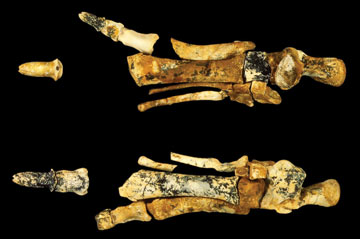|
NEWS NOTES
Roo roots
 Ben Kear |
| These 25-million-year-old foot bones show that early kangaroos didn't hop, but they might have climbed trees. |
No trip to Australia would be complete without spotting a kangaroo hopping across the grassy terrain. But a newly discovered kangaroo fossil suggests that wouldn’t have been possible 25 million years ago. Back then, Australia was covered by forests and kangaroos had not yet evolved their trademark hopping.
While excavating limestone outcrops in northeastern Australia, paleontologist Ben Kear of Australia’s La Trobe University in Melbourne and colleagues discovered the skull and partial skeleton of an extinct relative of modern kangaroos. They named it Nambaroo gillespieae, and Kear says it is the oldest, most complete example of an early kangaroo ever uncovered. Previously, researchers had only ever found isolated bits of kangaroo teeth, jaw and skull fragments from this early period in kangaroo history. “We had no idea what these things looked like,” Kear says. “This is the first snapshot of an ancient kangaroo from 25 million years ago.”
Built like a heavy-set, medium-sized dog, N. gillespieae looked like a cross between a kangaroo and an opossum, Kear says. Although the species definitely displays kangaroo features, its hind limbs and feet indicate it did not hop on two legs. Instead, the critter bounded about on all fours, and the species’ opposable big toe suggests it may have been able to climb, Kear and his colleagues reported in November’s Journal of Paleontology.
The species’ traits made it well-suited to life in the forest, and supports the idea that “kangaroo evolution goes hand in hand with climate change in Australia,” Kear says. Australia was heavily forested until about 15 million years ago. At that time, arid conditions set in, and the continent’s forests shrank while grasslands expanded. By 10 million years ago, modern-looking kangaroos show up in the fossil record, and more forest-adapted kangaroos like N. gillespieae were likely replaced by the direct ancestors of hopping kangaroos whose teeth probably made them more capable of chewing the widely available grasses, Kear says.
“It’s really exciting for once to have skeletal elements associated with teeth and jaws,” says Leah Schwartz, a paleontologist at New York University in New York City. “It does fit with our idea of what a primitive kangaroo at this time should look like.” Paleontologist Gavin Prideaux of Australia’s Flinders University in Adelaide agrees, pointing out that N. gillespieae probably lived a life similar to that of the most primitive kangaroo alive today — the musky rat-kangaroo, a tiny forest-dwelling species that doesn’t hop. But only with more discoveries of post-cranial remains from different kangaroos that lived over the past 25 million to 10 million years will paleontologists be able to figure out exactly when and why hopping evolved, Schwartz says. Such evidence would also allow researchers to determine why the spread of grasslands in other parts of the world never led to the development of hopping in other herbivorous mammals, Prideaux adds.

 Subscribe
Subscribe


